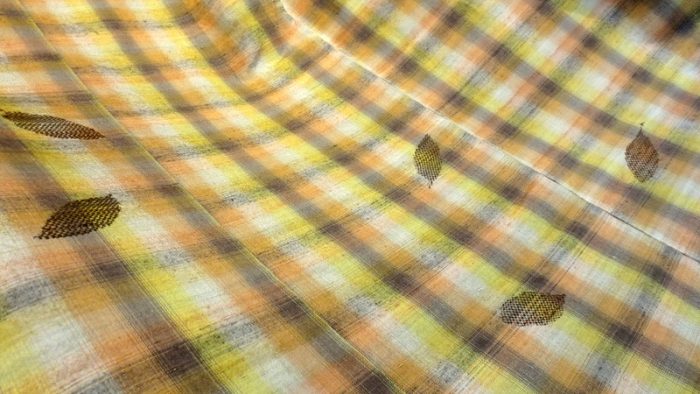The Hirota Tsumugi Blog
- 2019.02.22
- 100 % Plant-dyed Tsumugi Silk from Nigata

Mr. and Mrs. Matsumoto’s tsumugi textiles are made in one of the heaviest snowfall areas in Japan. We would like to introduce one of their unique products, a 100% plant-dyed gradational plaid weaving, embroidered with falling leaves.
Matsumoto’s vegetation dyes employ not the materials they buy in, but all being collected by themselves. They even use their own straw ashes harvested on their farmland, which are used for silk refining process, and finally the dyed yarns are loomed by hand loom (takabata loom). The textiles are inspiringly soft and one of a kind texture.

This textile is no exception, uses 6 different plants; akaimo (colocasia esculenta), small carpetgrass (arthraxon hispidus),Beggar ticks, mountain cherry blossom, Yomogi (Japanese mugwort), great burnet. Mr. Matsumoto ride his bike to surrounding mountain forest searching for such dyeing materials, which requires enormous time to dye enough yarns for a tan (one bolt of textile).

They wrote this label, which says, each plants used for dyeing, and about straw ash refining.
The weaving is always done by Mrs. Humiko, and this product has the leaves pattern. At the glance it looks like needlework, yet, it is done by one of weaving methods, sukui weaving. It is very rare to see their works with such a playful touch. Their textiles are in the first place very limited, so that this work has scarcity value.

With sukui weaving technique, the leaves are expressed by the running weft yarns.

leaves are placed at the right effect in the form of kimono.
The leaves are designed to being accent to the tailored kimono. The leaves are practically inconspicuous as you can see. We can understand Mr. and Mrs. Matsumoto’s aesthetic consideration where an excessive decoration is avoided for a kimono.
